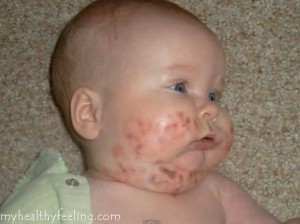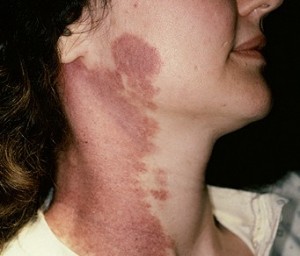Port-wine stain, affecting 3 babies out of 1000 babies born, is immediately noted at birth because it is characterized by a pinkish mark on the skin. This can either be a small birthmark or a large birthmark. Children born with port-wine stain normally feel conscious, especially if the birthmark occurs in a visible part of the body such as the neck, face, legs and arm. As they grow, port-wine stain also grows and often become darker. So children with port-wine stain may feel uncomfortable and even embarrassed. Check out other birthmarks on babies.
Port-wine stain treatment helps children born with unsightly birthmarks by boosting their self- confidence and esteem. This is especially important when they are entering the challenging teenage years, where children want to feel accepted by their peers. Treatment for port-wine stains may come in different forms, and it depends on the severity of the stain.
What is Port-wine stain?
Port-wine stain is nothing but a birthmark that is largely made up of small blood vessels. It is a rare disorder which occurs when the blood vessels swell. It does not cause any pain or problems, though it sometimes signifies other medical issues. These stains may occur in any part of the body, but they are commonly seen around the neck, legs, arms, scalp and face. Port-wine stains may be of any size and they usually grow as the child grows. The texture also changes over time and may become bumpy during adulthood.
What causes Port-wine stain?
Until now, scientists do not know the exact cause of port-wine stains. But it is assumed that it occurs due to the weakening of nerves that regulate the expansion of blood vessels in the affected area. The continuous expansion of blood vessels allows huge amounts of blood to enter into the blood vessels thus causing the formation of the stain underneath skin. The area where the port-wine stain develops signifies that there is inadequate supply of nerve fibers that keep the blood vessels constricted.
How do port-wine stains look like?
Port-wine stains look like pink marks at birth. But as the child grows, it gets even darker, either in dark red hue or reddish-purple shade. They may start out as flat patches and eventually get thick and bumpy during adulthood. Some port-wine stains develop in areas of the body which are barely noticeable. However, it really poses a problem if it develops on the face and other body parts which are quickly noticed by the naked eye.
What issues may arise due to port-wine stains?
When port-wine stains develop on the face, it could really be embarrassing especially for kids. They will feel insecure and have low self-esteem. Because it is visible, children with port-wine stains on the face receive plenty of rude stares or scornful questions from other people. This can be a hurtful experience for both children and parents. A child whose port-wine stain is on the face finds it hard to mingle with their peers due to his or her look, forcing him or her to hide instead.
When does a port-wine stain become a cause for concern?
Port-wine stains may be harmless birthmarks. But sometimes it can become a cause of concern especially when they are found:
- Close to the eye or forehead
Port-wine stains found in these areas may signify that there is a stain on the brain known as Sturge-Weber Syndrome. Sturge-Weber Syndrome is a very rare form of neurological disease which causes learning disabilities, developmental delays and seizures. Port-wine stains in these areas are closely monitored.
- On the eyelids
Port-wine stains found on the eyelids may lead to glaucoma. Glaucoma is the condition in which the optical nerve is damaged due to increased pressure within the eyes affecting the vision and eventually results to blindness.
If there is any concern about the port-wine stain’s location or associated symptoms, seek doctor’s help for proper diagnosis.
Port-wine stain treatment, removal
Port-wine stain greatly affects the child’s self-confidence regardless of its size and location. The most popular method of treating the condition is laser therapy. Plastic surgeons and dermatologists use pulsed-dye laser. Pulsed-dye laser therapy is not so painful but the patient may feel uncomfortable. Kids are given either a shot or ointment of anesthesia while general anesthesia may be given to younger ones. The treated area may have bruises and swelling, but these will subside within 10 days. Port-wine stains can also be treated with freezing, surgical skin grafts, dermabrasion and radiation. Some adults even opt for tattooing to treat port-wine stain.
How to care for port-wine stains?
It is important to apply moisturizer to port-wine stains because they dry up sometimes. Children treated with pulsed-dye laser therapy should never scratch or rub the port-wine stain area and the wound must be cleansed using lukewarm water.
Port-wine stain is a rare disorder caused by the swelling of blood vessels. It is a harmless birthmark that may occur on any part of the body, but it is commonly found in highly noticeable areas like face, arms, legs, neck and scalp. There may be plenty of choices for treating port-wine stain, but laser therapy is the most common and effective treatment especially for kids.
Portwine Stain Pictures
Check out the portwine birthmark photos and how they look on the skin

